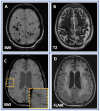Clinical Characteristics, Neuroimaging Markers, and Outcomes in Patients with Cerebral Amyloid Angiopathy: A Prospective Cohort Study
- PMID: 37685658
- PMCID: PMC10488273
- DOI: 10.3390/jcm12175591
Clinical Characteristics, Neuroimaging Markers, and Outcomes in Patients with Cerebral Amyloid Angiopathy: A Prospective Cohort Study
Abstract
Background and purpose: Sporadic cerebral amyloid angiopathy (CAA) is a small vessel disease, resulting from progressive amyloid-β deposition in the media/adventitia of cortical and leptomeningeal arterioles. We sought to assess the prevalence of baseline characteristics, clinical and radiological findings, as well as outcomes among patients with CAA, in the largest study to date conducted in Greece. Methods: Sixty-eight patients fulfilling the Boston Criteria v1.5 for probable/possible CAA were enrolled and followed for at least twelve months. Magnetic Resonance Imaging was used to assess specific neuroimaging markers. Data regarding cerebrospinal fluid biomarker profile and Apolipoprotein-E genotype were collected. Multiple logistic regression analyses were performed to identify predictors of clinical phenotypes. Cox-proportional hazard regression models were used to calculate associations with the risk of recurrent intracerebral hemorrhage (ICH). Results: Focal neurological deficits (75%), cognitive decline (57%), and transient focal neurological episodes (TFNEs; 21%) were the most common clinical manifestations. Hemorrhagic lesions, including lobar cerebral microbleeds (CMBs; 93%), cortical superficial siderosis (cSS; 48%), and lobar ICH (43%) were the most prevalent neuroimaging findings. cSS was independently associated with the likelihood of TFNEs at presentation (OR: 4.504, 95%CI:1.258-19.088), while multiple (>10) lobar CMBs were independently associated with cognitive decline at presentation (OR:5.418, 95%CI:1.316-28.497). cSS emerged as the only risk factor of recurrent ICH (HR:4.238, 95%CI:1.509-11.900) during a median follow-up of 20 months. Conclusions: cSS was independently associated with TFNEs at presentation and ICH recurrence at follow-up, while a higher burden of lobar CMBs with cognitive decline at baseline. These findings highlight the prognostic value of neuroimaging markers, which may influence clinical decision-making.
Keywords: TFNEs; apolipoprotein E; cSS; cerebral amyloid angiopathy; cognitive decline; microbleeds.
Conflict of interest statement
The authors declare no conflict of interest.
Figures


References
LinkOut - more resources
Full Text Sources

